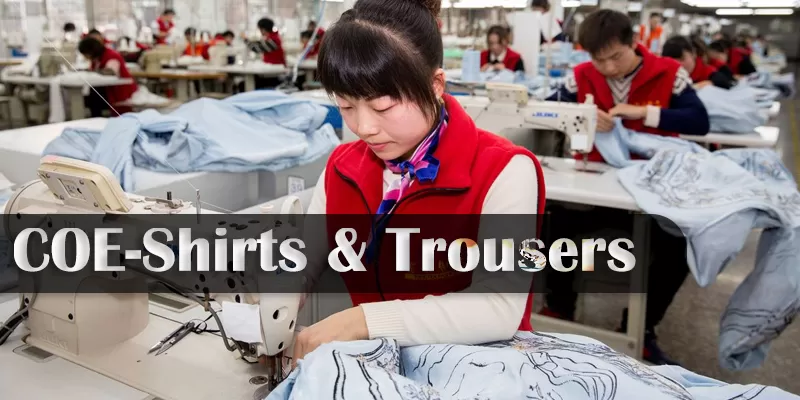
👕 COE - Shirts & Trousers
🔹 Introduction
The COE - Shirts & Trousers trade is designed to equip students with professional skills in garment making, focusing on the production of shirts and trousers. This course helps trainees develop expertise in pattern making, cutting, stitching, and finishing, ensuring high-quality garment production. It is ideal for those who want to enter the textile and fashion industry, start their own tailoring business, or work in garment manufacturing units.
🔹 Objectives 🎯
Upon successful completion of this course, students will:
- Understand fabric selection and garment construction techniques 🏗️
- Learn to create patterns for shirts and trousers 📏
- Master cutting, stitching, and finishing processes ✂️
- Operate industrial and domestic sewing machines effectively 🧵
- Gain knowledge of quality control in garment production ✅
- Develop entrepreneurial skills to start their own business 💼
- Learn customer handling and garment alteration techniques 👔👖
🔹 Course Structure 📚
The COE - Shirts & Trousers course covers a wide range of topics, including:
1️⃣ Introduction to Textile & Fabrics 🏗️
- Types of fabrics used for shirts and trousers 🧵
- Properties of natural and synthetic fibers 🌿
- Fabric identification and selection for different garments 🔍
- Fabric grain, bias, and stretch analysis 📏
- Shrinkage and color fastness testing 🧼
2️⃣ Basic Sewing Machine Operations 🏭
- Understanding different types of sewing machines 🛠️
- Threading and maintenance of machines 🔄
- Machine troubleshooting and repair ⚙️
- Use of different sewing machine attachments 🎛️
- Speed control and stitch quality enhancement 🚀
3️⃣ Pattern Making & Drafting 📐
- Measurement techniques for shirts and trousers 📏
- Drafting basic shirt and trouser patterns ✍️
- Adaptation of patterns for different styles 👕
- Use of CAD software for pattern making 💻
- Layout planning and fabric utilization 🔄
4️⃣ Fabric Cutting Techniques ✂️
- Understanding different cutting methods 🪓
- Manual vs. industrial cutting techniques 🔪
- Pattern marking and layout arrangement 📏
- Use of cutting machines for bulk production ⚙️
- Precautionary measures for accuracy and safety 🦺
5️⃣ Shirt Making Process 👔
- Construction of different shirt styles (formal, casual, designer) 🎽
- Collar and cuff variations (classic, band, spread) 🧣
- Sleeve setting and finishing techniques 👕
- Buttonhole stitching and placket construction 🎛️
- Shirt fitting and alteration methods 🔄
6️⃣ Trouser Making Process 👖
- Drafting and cutting trouser patterns 📏
- Stitching methods for different types of trousers (formal, casual, jeans) 🪡
- Waistband, pleats, and pocket construction 🎽
- Zipper and fly attachment techniques 🎛️
- Pressing and finishing for a professional look 🧼
7️⃣ Quality Control & Finishing ✅
- Checking seam strength and fabric defects 🔍
- Ensuring proper fit and alignment 📐
- Ironing and pressing techniques for a polished finish 🚀
- Final inspection before packing and delivery 📦
- Packaging and labeling techniques for garments 🏷️
8️⃣ Entrepreneurship & Business Management 💼
- Setting up a tailoring or garment production unit 🏭
- Understanding garment costing and pricing 💰
- Marketing and branding strategies 📢
- Customer service and order management 🤝
- Legal compliance and taxation for garment businesses 📜
🔹 Learning Outcomes 🎓
By the end of this course, students will: ✅ Gain expertise in making professional-quality shirts and trousers 👕👖 ✅ Understand pattern making, fabric cutting, and garment construction ✂️ ✅ Operate sewing machines efficiently and troubleshoot minor issues ⚙️ ✅ Learn garment finishing and quality control techniques ✅ ✅ Develop skills to start their own tailoring business 🏪 ✅ Enhance employability in the garment and textile industry 🏭
🔹 Job Opportunities 💼
After completing the course, students can work as: ✅ Tailor / Garment Maker ✂️ ✅ Pattern Master 📏 ✅ Apparel Production Supervisor 🏭 ✅ Fashion Designer Assistant 🎨 ✅ Textile Quality Inspector ✅ ✅ Self-Employed Tailor or Boutique Owner 🏪
🔹 Conclusion 🏁
The COE - Shirts & Trousers trade provides a strong foundation for those aspiring to join the garment industry. With hands-on training in sewing, pattern making, and fabric selection, students gain the necessary skills to build a successful career in apparel production. Whether working for a fashion house, a garment manufacturing unit, or starting their own business, this trade offers numerous opportunities for professional growth and success. 👔👖🧵
